Initial release date 1996 | ||
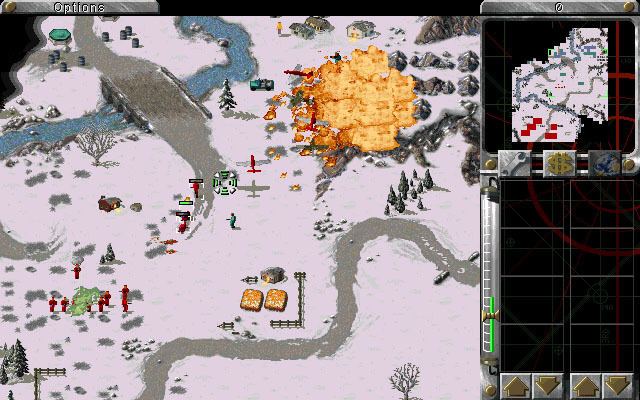 | ||
Release date(s) PCNA: November 22, 1996EU: 1996PlayStationNA: October 31, 1997EU: November 1997PlayStation NetworkPAL: March 27, 2008NA: November 12, 2009 Mode(s) Single-player, multiplayer Series Command & Conquer: Red Alert, Command & Conquer Publishers Electronic Arts, Virgin Interactive, Sony Interactive Entertainment, Virgin Interactive Entertainment (Europe) Ltd. Similar Command & Conquer games, Westwood Studios games, Real-time strategy games | ||
Command & Conquer: Red Alert is a real-time strategy video game of the Command & Conquer franchise, produced by Westwood Studios and released by Virgin Interactive in 1996. The second game to bear the "Command & Conquer title, Red Alert is the prequel to the original Command & Conquer of 1995, and takes place in the alternate early history of Command & Conquer when Allied Forces battle an aggressive Soviet Union for control over the European mainland.
Contents
- Gameplay
- Plot
- Connection to the Tiberian games
- Internet gameplay
- Freeware release
- Soundtrack
- Reception
- Counterstrike and The Aftermath 1997
- Command and Conquer Red Alert Retaliation 1998
- Open source remake
- References
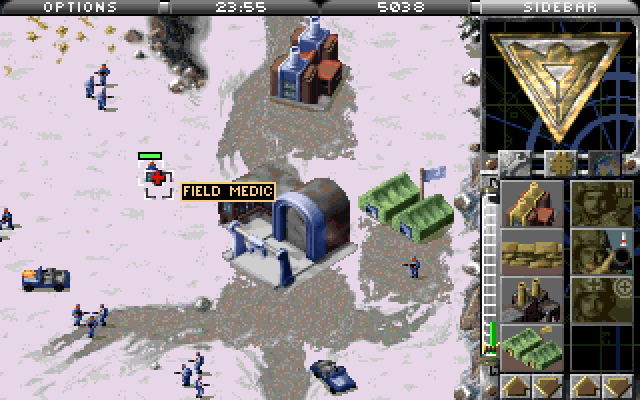
It was initially available for PC (MS-DOS and Windows 95 versions included in one package), and was subsequently ported to PlayStation. The PlayStation version was also re-released as a download on the PlayStation Network for PlayStation Portable and PlayStation 3. On August 31, 2008, Electronic Arts who acquired Westwood Studios in 1998 rendered Command & Conquer: Red Alert freeware.
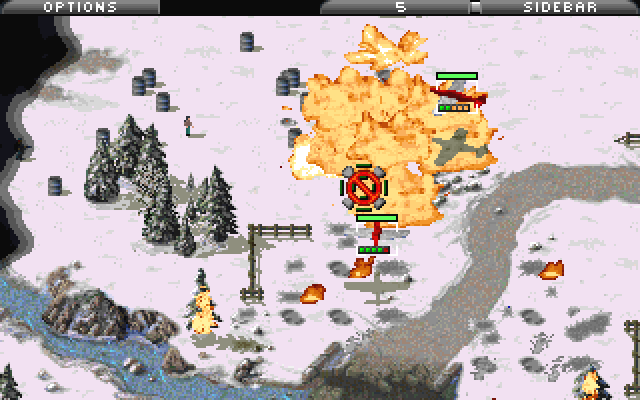
Gameplay
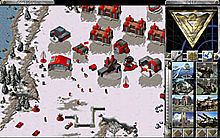
Red Alert was praised for its user interface, which claimed to be more developed than the competing games of its time. Players could queue commands, create unit groups that could be selected by a number key, and control numerous units at a time. The game was known to be easy to control, simple to learn and responsive to users' commands. It also featured two factions that had differing styles of play. Red Alert is also hailed as one of the first games to feature competitive online play. The single player campaign also received high praise for its detailed story line and missions, which often required the player to defeat the enemy with various sets of circumstances before continuing. Like Tiberian Dawn, the game has split routes for most missions. The objective stays the same but only the map layout differs. The single player campaign was also complemented by live action cinematic sequences that are a feature of all Command & Conquer RTS games since the original, except for Command & Conquer: Generals and its sequel.
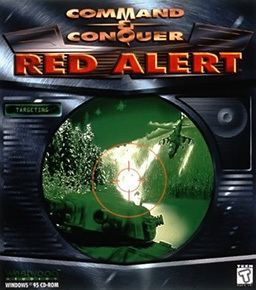
The game balance between the forces of the Allied and Soviet armies differed from other games at its time. Unlike the 'rock-paper-scissors' balancing of modern games, Red Alert required each player to use their side's strengths in order to compensate for their weaknesses. This stood in contrast to games such as Total Annihilation or Warcraft II: Tides of Darkness, in which both sides had units with similar abilities and relied instead on outnumbering or possessing a better balanced force than their opponent.
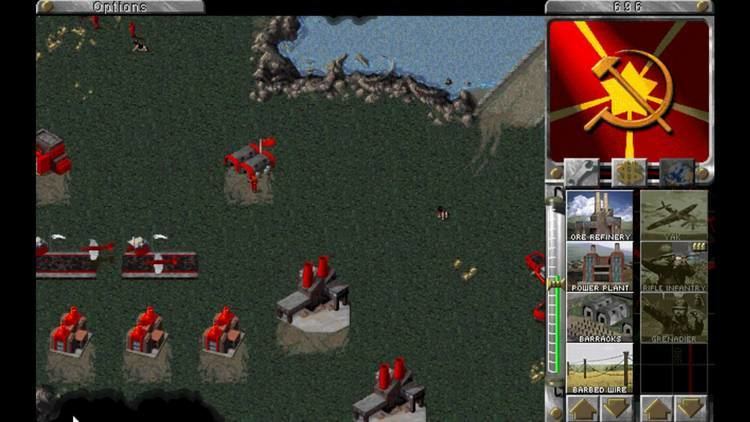
Players acquire credits to purchase structures and equipment by mining for ores and minerals (as the valuable, yet hazardous Tiberium in the regular C&C series has not yet been discovered in this timeline). Rare gems generate more credits and are faster to mine, but unlike ores, do not regenerate within the map. Players can gain more credits and increase their buying power by building more ore factories and ore trucks.
The Soviets' vehicles tend to be more durable and powerful than Allied vehicles, but are often slower moving and more expensive. The Soviets also have superior defensive capabilities against ground attacks, with the Flame Towers and Tesla coil, the latter able to destroy most Allied armor in 1-2 hits although it has high power consumption. The Soviets' weakness is at sea; their only offensive naval unit is the submarine, which exists to counter Allied warships and gain intelligence. It is normally invisible except when surfacing to attack, when it is vulnerable to destroyers and gunboats. The Soviets' secret weapon is the Iron Curtain, a device that renders a selected unit invulnerable to attacks for a short period of time. They also have a wide selection of air units for assault (the MiG-27, Yak-7, and Mi-24 Hind) and map revelation through spy planes, and can deploy infantry by air through paratroops or by the Chinook transport helicopter (the latter only present in multiplayer). The Soviet "tank rush" was a popular strategy online, involving building many heavy tanks and overwhelming the opponent with sheer numbers.
The Allies' forces are generally cheaper, faster to build and more agile. Their infantry can survive longer with good use of their Medic unit. The Allies' strongest tank (the Medium Tank) is weaker in a one-on-one engagement against the Soviets' starting tank (the Heavy Tank), but the Allies also have anti-tank minelayers to counter superior Soviet armor. The Allies have only one air unit, the anti-tank AH-64D Apache Longbow, compared to three Soviet air units; however, the Allies also have anti-aircraft guns (more powerful but shorter-ranged than Soviet Surface to Air Missiles). Allied defenses against ground assaults—pillboxes and turret emplacements—are less powerful than the Soviets' Tesla Coil, but stronger and less dependent on power. On maps with water, Allies possess an advantage in naval power thanks to the Cruiser, which has the longest-ranged and most powerful surface-to-surface attack in the game, as its naval artillery can destroy buildings quickly; and the Destroyer, which is versatile and capable of adeptly taking on any type of unit type in the game—land, sea, or air. The Allies' secret weapon is the Chronosphere, which temporarily relocates a selected unit to another part of the map. They also possess several other tools of subterfuge and military intelligence, such as spies to gain information on or disable enemy facilities, and thieves for stealing enemy resources, hiding their own units and structures from detection, and revealing the whole game map with a GPS satellite.
In online play and computer skirmish, both Allied and Soviet forces have access to the nuclear Missile Silo, which is not available to either side in single-player mode, although it is present in the Allied campaign. In online play and computer skirmishes, the Soviets have access to two of the Allied side's infantry: the Rocket Soldier (for anti-air and anti-tank fighting) and Tanya, a commando capable of easily killing infantry and destroying structures.
Plot
Command & Conquer: Red Alert takes place between 1946 and 1953 of a parallel universe.
Starting out at the Trinity Site in New Mexico in 1946 (in our timeline), Albert Einstein prepares to travel backward in spacetime. He activates his experimental time machine to find himself in Landsberg, Germany, on 20 December 1924, where he meets a young Adolf Hitler just after the latter's release from Landsberg Prison. Following a brief conversation between the two, Einstein shakes Hitler's hand while activating his time-traveling device. In the process of Einstein returning to his time of origin, Hitler dies due to the lack of his own equipment for the transit through time. (This is implied by the Allies' Chronosphere in-game, in which usage of its power on soldiers kills them.)
Hitler's death prevents him from rising to power as leader of Nazi Germany. This creates a new timeline, in which eliminating Hitler's actions has caused a change for the worse. Without Nazi Germany, the Soviet Union grew powerful under the rule of Joseph Stalin. Unweakened, the USSR seizes land from China and then invades Eastern Europe, to achieve Joseph Stalin's vision of a Soviet Union stretching across the entire Eurasian landmass. In response, the nations of Europe form the Alliance, and start a guerrilla war against the invading Soviet army. Over the course of the game's story, the Allies and Soviets fight for control over the European mainland in an alternate World War II.
Connection to the Tiberian games
Westwood Studios designed Command & Conquer: Red Alert to be the prequel of Command & Conquer: Tiberian Dawn, and by proxy of the Tiberian series as a whole.
During the course of the Soviet's campaign, Kane is seen to make infrequent appearances as a mysterious counselor to Joseph Stalin, and the story implies that he has in fact been the instigator of the world war between the USSR and the Allied nations in order to further the long-term goals of the Brotherhood of Nod. Indeed, Nadia, the head of the NKVD, Stalin's mistress and evidently a secretive member of the Brotherhood herself as early as the 1950s, instructs the player to "keep the peace" until Nod would "tire of the USSR in the early 1990s" upon the campaign's successful conclusion. Kane however shoots her without warning, and proclaims to the player that he "[is] the future". Moreover, during the fifth cutscene of the Allied campaign, a news announcer reporting on the Allies' loss of Greece is suddenly heard stating that the United Nations are in the process of bringing about a unique military task force aimed at preventing future globalized conflicts. This task force is heavily implied to have been "Special Operations Group Echo: Black Ops 9"—the covert and international peace enforcing unit of the United Nations and the precursor of the Global Defense Initiative, one of the two main and iconic factions of the Tiberian series alongside the Brotherhood of Nod.
A much debated theory intended to resolve the apparent timeline error which came to exist between Command & Conquer: Tiberian Dawn and Command & Conquer: Red Alert 2 is to consider Red Alert as the genesis of two parallel storylines. If the Soviet campaign were to be completed in Red Alert, the USSR would emerge as the dominant Eurasian power and Kane and the Brotherhood of Nod would subsequently take control of this new empire. Conversely, if the Allied campaign were to be completed, the Allies would emerge victorious and the timeline would instead lead into the events of Red Alert 2 (though Red Alert 2 completely ignores anything that could connect it to the Tiberium timeline). According to former C&C designer Adam Isgreen, however, Tiberian Dawn in fact follows on the conclusion of Red Alert's Allies campaign, while Red Alert 2 and Yuri's Revenge take place in a second parallel universe, created by a new attempt to alter history in "Tiberian Incursion", the working title of Westwood Studios' cancelled version of Command & Conquer 3. Isgreen also implied that Nikola Tesla may have been responsible for inadvertently having attracted the attention of the Scrin through his experiments, and thus for the arrival of Tiberium on Earth.
When the Command & Conquer: The First Decade compilation pack was released in February 2006, Electronic Arts adopted the policy of considering the C&C franchise to consist of three distinct universes, with this decision apparently violating the storyline connections between Red Alert and Tiberian Dawn established by Westwood Studios. With the release of Command & Conquer 3: Tiberium Wars in March 2007 however, Electronic Arts published a document wherein an explicit reference to Kane's appearance in Red Alert is made—revealing that GDI's "InOps" intelligence division is in the possession of photos of Kane which were taken by CIA operatives during the 1950s era of Red Alert.
Internet gameplay
Internet gameplay was officially supported by Westwood Chat up until 1996. Since then many unofficial places do support it. The de facto place to play online today is CnCNet, which has at least 100 players online any given time of the day, and has peaked at over 600 players in 2016.
Freeware release
To mark the 13th anniversary of Command and Conquer and the announcement of Red Alert 3, EA has released Command and Conquer: Red Alert as freeware. After the promotion ended they allowed third-party mirrors to pick up and also ship the addons for free. The community has started repackaging it to installers that do not require burning the original ISO images and included their latest fan patches that modernize the renderer, remove duplicate files, fix bugs and include content from the PlayStation release, too. Those repacks typically also include modding tools as well as network utilities for multiplayer matches.
Soundtrack
The game's original score was composed by Frank Klepacki and was voted the best video game soundtrack of 1996 by PC Gamer and Gameslice magazines.
Reception
The PC version of the game scored in the range 90%. Computer Gaming World gave it the Strategy Game of the Year award (Readers' Choice).
Counterstrike and The Aftermath (1997)
In 1997, two expansion packs for Red Alert were released for the PC, Command & Conquer: Red Alert: Counterstrike, and Command & Conquer: Red Alert: The Aftermath. The expansion packs were designed by Westwood Studios with the "apprenticeship" of Intelligent Games, a London-based game developer. Much of the development on multiplayer maps was undertaken by players from the Compuserve Red Alert ladder. New units, missions, maps and music were included in the expansions.
Of particular note with the Counterstrike add-on is the addition of the secret Ant Missions titled "It Came from Red Alert", where the player battles against an army of giant, mutant ants with Allied Forces and Soviet units.
The Aftermath add-on added many new units available in single and multiplayer modes. New Allied units include the Field Mechanic and the Chrono Tank. New Soviet units include the Missile Sub, the Shock Trooper, the M.A.D Tank and the Tesla Tank. In addition, both sides receive the Demolition Truck. The add-on also includes hundreds of new maps as well as a new, significantly larger, map size.
Command and Conquer: Red Alert: Retaliation (1998)
On August 28, 1998, Westwood Studios released Command and Conquer: Red Alert: Retaliation for the PlayStation, a compilation of the two PC expansion packs, including the secret Ant Missions. It is almost identical to the PlayStation port of the original Red Alert, except it introduced some new units like Tesla Tank, Shock Trooper, Chrono Tank and Mechanic, and included 105 skirmish maps. Gameplay also included an in-game sidebar code called Soylent Green Mode. In this mode all ore fields turn to people/civilians, and ore trucks harvest them with grisly sound effects.
It also included 19 exclusive briefing FMV (full-motion video) clips that were not in any of the PC expansion packs, which had none. All of the videos are shown when the player either starts playing through the operational theatre from the beginning or when all the missions of the theatre are accomplished. In other cases, the briefing text is shown. The FMVs include a general for each side, telling the player the mission objectives; The Allied General Carville later appears in Red Alert 2 while Soviet General Topolov has made no further appearances in the Red Alert series.
The Retaliation videos are available for the PC Red Alert in the Red Alert modification The Lost Files. This modification adds the Retaliation videos to the Counterstrike and Aftermath missions. It requires Red Alert patch v3.03 or Red Alert patch v3.03 TFD (for the Red Alert version of the C&C The First Decade package).
Red Alert Retaliation was released as a download for PSP and PS3 from the PlayStation Network in Europe on December 4, 2008 and in North America on December 3, 2009.
Open source remake
A modern video game remake and re-implementation of the game engine was created by fans called OpenRA. It is available for Linux, macOS and Windows NT and is written in C#. It adds gameplay elements from successors such as fog of war. The focus is primarily on skirmish/multiplayer gaming with partial support for the single-player missions. Features missing from the original such as replay recording and an observer mode have been added and given rise to a small hobbyist e-sports scene.
